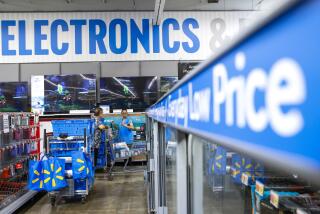Retail Sales Last Month Stalled by Gas Prices
Retailers on Thursday reported a mostly ho-hum July, the second straight month of tepid sales, as steep gasoline prices and scanty clearance racks gave consumers fewer reasons to spend.
Overall, retail sales rose 2.6% for stores open at least a year, according to the Goldman Sachs retail composite index. That was just slightly above the firm’s conservative estimate of a 2.5% gain.
Some apparel merchants, notably San Francisco-based Gap Inc. and Foothill Ranch-based Wet Seal Inc., fared considerably worse.
Gap said sales fell 5% from July 2003 with declines in all its divisions -- Gap, Banana Republic and Old Navy -- that were well below analysts’ predictions of a 1% to 3% sales gain. Wet Seal said sales fell 14.7%. As a group, specialty apparel sellers fell 0.5%, according to the Goldman Sachs index.
Retail stocks were pounded by investors. The Morgan Stanley index of retail stocks fell 3.2%, with 35 of its 38 members losing ground on the day. Gap shares fell $1.59, or 7.4%, to $19.79 on the New York Stock Exchange. Wet Seal plunged $1.26, or 29.6%, to $3 on Nasdaq.
“It was a tough month for everybody,” said Adrienne E. Tennant, an analyst with Wedbush Morgan Securities in Los Angeles.
For some merchants, August may not be much better. High gasoline prices, a steep decline in mortgage refinancings, which had put cash in consumers’ pockets, and little growth in real wages are likely to curtail many shoppers’ spending plans.
August is an increasingly important month for retailers, signaling the start of the back-to-school season, one of the busiest selling periods of the year.
“The longer oil prices stay at the high levels that they are, the more damaging that’s going to be to consumer spending and the consumer mind-set,” said Brian Holland, director of research at Cleveland-based Boyd Watterson Asset Management, which includes shares of Target Corp. among its $4.3 billion in assets.
The average U.S. retail price for self-serve regular gasoline in July was $1.91, or 40 cents more than a year earlier, according to the U.S. Department of Energy.
A survey this year found that 55% of shoppers with annual incomes of less than $35,000 cut their driving because of higher gas prices, said Michael Niemira, chief economist of the International Council of Shopping Centers, which tracks about 80 retail chains.
Consumers who shop at discounters, such as Wal-Mart, would be particularly hurt by gas price increases, said Howard Davidowitz of consulting firm Davidowitz & Associates.
“That’s a huge part of their disposable income,” said Davidowitz, who is based in New York. “That customer is pressured.”
In a report released this week, retail analysts at Ernst & Young predicted slower sales growth in the second half of the year, even though they estimated that in 2004 sales would be double those of last year.
The July sales numbers could also be a sign that the nation’s economic performance during the third quarter may be no better than its lackluster growth in the spring.
The Commerce Department said last month that the economy slowed sharply during the second quarter, with a 3% annualized growth rate in gross domestic product -- the value of goods and services produced in the U.S.
Wal-Mart Stores Inc., which posted a July same-store sales gain of 3.2% mostly because of healthier sales at its Sam’s Club discount stores, said it remained cautious about sales in August, saying it foresaw a 2% sales gain -- far lower than the company’s usual gangbuster rate.
Same-store sales, or sales at stores open at least a year, are a key measure of a retailer’s health because the figure excludes new and closed stores, which can skew results.
Late-summer sales may look even more paltry compared with those of last August, when they were boosted by the government’s $400 child tax credit checks and an early Labor Day.
Still, some analysts and apparel sellers were hopeful about back-to-school sales, saying this fall’s new preppy look was already proving popular, particularly with teen buyers.
The trend could be positive for two of this month’s laggards, Gap and Wet Seal, said Wedbush Morgan’s Tennant, although she rated both stocks “hold.”
Wet Seal, with new fall merchandise just beginning to arrive in stores next week, will face a crucial test, she said.
“They still have a chance to really pull it out for back-to-school,” Tennant said. “I’m waiting on the sidelines because it’s really not clear whether this is a slam-dunk for them.”
*
Bloomberg News was used in compiling this report.
* (BEGIN TEXT OF INFOBOX)
Mixed bag
July retail sales were disappointing as several department stores and apparel merchants fell short of expectations.
Percentage change from a year earlier in sales at stores open at least one year Company % change Guess +14.1% J.C. Penney +8.1 Nordstrom +6.1 Pacific Sunwear +6.0 Target +4.1 Federated +3.7 Wal-Mart +3.2 Limited Brands 0.0 Gottschalks Ð0.4 Sears Ð2.6 Gap Ð5.0 Hot Topic Ð5.0 Ross Ð5.0 May Ð5.5 Wet Seal Ð14.7
Sources: Times wire services, company reports
More to Read
Inside the business of entertainment
The Wide Shot brings you news, analysis and insights on everything from streaming wars to production — and what it all means for the future.
You may occasionally receive promotional content from the Los Angeles Times.










